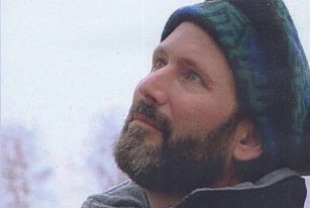One of the best books ever written about grace, letting go, and living in the present moment is Phil Simmons's Learning to Fall: The Blessings of an Imperfect Life. He was diagnosed at age 35 with the a degenerative neuromuscular condition ALS, commonly known as Lou Gehrig's disease. Doctors did not give him long to live. He had to give up his job as an associate professor of English at Lake Forest College, where he had taught literature and creative writing for nine years.
Simmons agreed to participate in a seminar on healing at Harvard Medical School and to allow filmmakers into his home in the foothills of the White Mountains. He wanted to convey an intimate portrait of himself, his family, friends, and caretakers. This courageous and creative man is shown at various stages in his 16-month journey towards death as "wrestling joy from heartbreak." The documentary is directed by Garry Beitel and produced by Beitel and Barry Lazar.
There are so many life-affirming and magic moments in this healing work that it is hard to pick just a few to highlight. We were immensely moved by our experience watching The Man Who Learned to Fall. We are convinced that it is an exceptional resource for our own encounter with death and the inner spiritual resources that need to be developed in the process of letting go of the body and all that is precious in life. Bless Phil Simmons for being such an unforgettable spiritual teacher of the things that truly matter.
One of the many delights in the documentary is the incredible loving relationship between Phil and his wife Kathryn, a sculptor and mother of two children. At one point, he describes "being joined at the heart to her." When they first met, his ability to tell stories is what convinced her that he was the one she was destined to marry. Throughout his ordeal she stands by him and weathers all the pain connected with his imminent death. They both see their work as a great gift of God. She goes to the studio and treasures the solitude and he goes to the computer where he carves sentences out of his experiences — both are totally absorbed in something that brings meaning to them personally and gives expression to their life energies.
Simmons treasures the kindness of friends and strangers who are there to help him with the things he cannot do for himself. In one poignant moment, he ponders how hard it was for him when he realized that he could no longer put on his socks. Simmons describes a moment when a caretaker kneels in front of him in a simple and humble gesture of kindness as reminding him of all the angels in his life who provide loving service. He also takes great pleasure in his chances to commune with his children and to draw strength from the beauty and the bounties of the natural world. Best of all is the brightness in Simmons's eyes when he laughs: for him, it is a divine space filled with light and freedom. He reads several passages from his book and they are so uplifting. Here is one on living in the present moment: it sums up what we have experienced in this extraordinary journey with Simmons and his wife Kathryn:
"The present moment, like the spotted owl or the sea turtle, has become an endangered species. Yet more and more I find that dwelling in the present moment, in the face of everything that would call us out of it, is our highest spiritual discipline. More boldly, I would say that our very presentness is our salvation; the present moment, entered into fully, is our gateway to eternal life."
